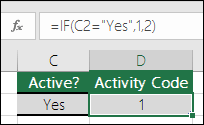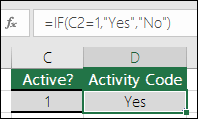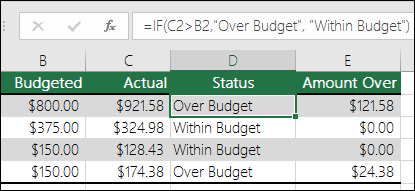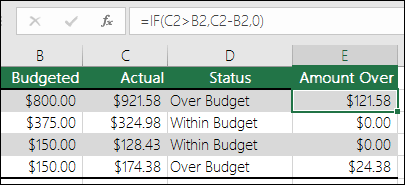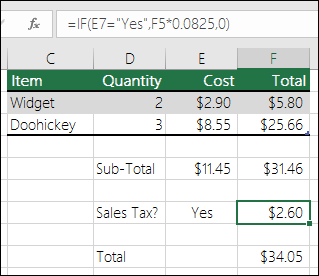IF function
The IF function is one of the most popular functions in Excel, and it allows you to make logical comparisons between a value and what you expect.
So an IF statement can have two results. The first result is if your comparison is True, the second if your comparison is False.
For example, =IF(C2=”Yes”,1,2) says IF(C2 = Yes, then return a 1, otherwise return a 2).
Use the IF function, one of the logical functions, to return one value if a condition is true and another value if it’s false.
IF(logical_test, value_if_true, [value_if_false])
For example:
-
=IF(A2>B2,»Over Budget»,»OK»)
-
=IF(A2=B2,B4-A4,»»)
|
Argument name |
Description |
|---|---|
|
logical_test (required) |
The condition you want to test. |
|
value_if_true (required) |
The value that you want returned if the result of logical_test is TRUE. |
|
value_if_false (optional) |
The value that you want returned if the result of logical_test is FALSE. |
Simple IF examples
-
=IF(C2=”Yes”,1,2)
In the above example, cell D2 says: IF(C2 = Yes, then return a 1, otherwise return a 2)
-
=IF(C2=1,”Yes”,”No”)
In this example, the formula in cell D2 says: IF(C2 = 1, then return Yes, otherwise return No)As you see, the IF function can be used to evaluate both text and values. It can also be used to evaluate errors. You are not limited to only checking if one thing is equal to another and returning a single result, you can also use mathematical operators and perform additional calculations depending on your criteria. You can also nest multiple IF functions together in order to perform multiple comparisons.
-
=IF(C2>B2,”Over Budget”,”Within Budget”)
In the above example, the IF function in D2 is saying IF(C2 Is Greater Than B2, then return “Over Budget”, otherwise return “Within Budget”)
-
=IF(C2>B2,C2-B2,0)
In the above illustration, instead of returning a text result, we are going to return a mathematical calculation. So the formula in E2 is saying IF(Actual is Greater than Budgeted, then Subtract the Budgeted amount from the Actual amount, otherwise return nothing).
-
=IF(E7=”Yes”,F5*0.0825,0)
In this example, the formula in F7 is saying IF(E7 = “Yes”, then calculate the Total Amount in F5 * 8.25%, otherwise no Sales Tax is due so return 0)
Note: If you are going to use text in formulas, you need to wrap the text in quotes (e.g. “Text”). The only exception to that is using TRUE or FALSE, which Excel automatically understands.
Common problems
|
Problem |
What went wrong |
|---|---|
|
0 (zero) in cell |
There was no argument for either value_if_true or value_if_False arguments. To see the right value returned, add argument text to the two arguments, or add TRUE or FALSE to the argument. |
|
#NAME? in cell |
This usually means that the formula is misspelled. |
Need more help?
You can always ask an expert in the Excel Tech Community or get support in the Answers community.

See Also
IF function — nested formulas and avoiding pitfalls
IFS function
Using IF with AND, OR and NOT functions
COUNTIF function
How to avoid broken formulas
Overview of formulas in Excel
Need more help?
The logical IF statement in Excel is used for the recording of certain conditions. It compares the number and / or text, function, etc. of the formula when the values correspond to the set parameters, and then there is one record, when do not respond — another.
Logic functions — it is a very simple and effective tool that is often used in practice. Let us consider it in details by examples.
The syntax of the function «IF» with one condition
The operation syntax in Excel is the structure of the functions necessary for its operation data.
=IF(boolean;value_if_TRUE;value_if_FALSE)
Let us consider the function syntax:
- Boolean – what the operator checks (text or numeric data cell).
- Value_if_TRUE – what will appear in the cell when the text or numbers correspond to a predetermined condition (true).
- Value_if_FALSE – what appears in the box when the text or the number does not meet the predetermined condition (false).
Example:
Logical IF functions.
The operator checks the A1 cell and compares it to 20. This is a «Boolean». When the contents of the column is more than 20, there is a true legend «greater 20». In the other case it’s «less or equal 20».
Attention! The words in the formula need to be quoted. For Excel to understand that you want to display text values.
Here is one more example. To gain admission to the exam, a group of students must successfully pass a test. The results are listed in a table with columns: a list of students, a credit, an exam.
The statement IF should check not the digital data type but the text. Therefore, we prescribed in the formula В2= «done» We take the quotes for the program to recognize the text correctly.
The function IF in Excel with multiple conditions
Usually one condition for the logic function is not enough. If you need to consider several options for decision-making, spread operators’ IF into each other. Thus, we get several functions IF in Excel.
The syntax is as follows:
Here the operator checks the two parameters. If the first condition is true, the formula returns the first argument is the truth. False — the operator checks the second condition.
Examples of a few conditions of the function IF in Excel:
It’s a table for the analysis of the progress. The student received 5 points:
- А – excellent;
- В – above average or superior work;
- C – satisfactory;
- D – a passing grade;
- E – completely unsatisfactory.
IF statement checks two conditions: the equality of value in the cells.
In this example, we have added a third condition, which implies the presence of another report card and «twos». The principle of the operator is the same.
Enhanced functionality with the help of the operators «AND» and «OR»
When you need to check out a few of the true conditions you use the function И. The point is: IF A = 1 AND A = 2 THEN meaning в ELSE meaning с.
OR function checks the condition 1 or condition 2. As soon as at least one condition is true, the result is true. The point is: IF A = 1 OR A = 2 THEN value B ELSE value C.
Functions AND & OR can check up to 30 conditions.
An example of using the operator AND:
It’s the example of using the logical operator OR.
How to compare data in two tables
Users often need to compare the two spreadsheets in an Excel to match. Examples of the «life»: compare the prices of goods in different bringing, to compare balances (accounting reports) in a few months, the progress of pupils (students) of different classes, in different quarters, etc.
To compare the two tables in Excel, you can use the COUNTIFS statement. Consider the order of application functions.
For example, consider the two tables with the specifications of various food processors. We planned allocation of color differences. This problem in Excel solves the conditional formatting.
Baseline data (tables, which will work with):
Select the first table. Conditional Formatting — create a rule — use a formula to determine the formatted cells:

In the formula bar write: = COUNTIFS (comparable range; first cell of first table)=0. Comparing range is in the second table.
To drive the formula into the range, just select it first cell and the last. «= 0» means the search for the exact command (not approximate) values.
Choose the format and establish what changes in the cell formula in compliance. It’s better to do a color fill.
Select the second table. Conditional Formatting — create a rule — use the formula. Use the same operator (COUNTIFS). For the second table formula:
Download all examples in Excel
Now it is easy to compare the characteristics of the data in the table.
The IF function runs a logical test and returns one value for a TRUE result, and another value for a FALSE result. The result from IF can be a value, a cell reference, or even another formula. By combining the IF function with other logical functions like AND and OR, you can test more than one condition at a time.
Syntax
The generic syntax for the IF function looks like this:
=IF(logical_test,[value_if_true],[value_if_false])The first argument, logical_test, is typically an expression that returns either TRUE or FALSE. The second argument, value_if_true, is the value to return when logical_test is TRUE. The last argument, value_if_false, is the value to return when logical_test is FALSE. Both value_if_true and value_if_false are optional, but you must provide one or the other. For example, if cell A1 contains 80, then:
=IF(A1>75,TRUE) // returns TRUE
=IF(A1>75,"OK") // returns "OK"
=IF(A1>85,"OK") // returns FALSE
=IF(A1>75,10,0) // returns 10
=IF(A1>85,10,0) // returns 0
=IF(A1>75,"Yes","No") // returns "Yes"
=IF(A1>85,"Yes","No") // returns "No"Notice that text values like «OK», «Yes», «No», etc. must be enclosed in double quotes («»). However, numeric values should not be enclosed in quotes.
Logical tests
The IF function supports logical operators (>,<,<>,=) when creating logical tests. Most commonly, the logical_test in IF is a complete logical expression that will evaluate to TRUE or FALSE. The table below shows some common examples:
| Goal | Logical test |
|---|---|
| If A1 is greater than 75 | A1>75 |
| If A1 equals 100 | A1=100 |
| If A1 is less than or equal to 100 | A1<=100 |
| If A1 equals «Red» | A1=»red» |
| If A1 is not equal to «Red» | A1<>»red» |
| If A1 is less than B1 | A1<B1 |
| If A1 is empty | A1=»» |
| If A1 is not empty | A1<>»» |
| If A1 is less than current date | A1<TODAY() |
Notice text values must be enclosed in double quotes («»), but numbers do not. The IF function does not support wildcards, but you can combine IF with COUNTIF to get basic wildcard functionality. To test for substrings in a cell, you can use the IF function with the SEARCH function.
Pass or Fail example
In the worksheet shown above, we want to assign either «Pass» or «Fail» based on a test score. A passing score is 70 or higher. The formula in D6, copied down, is:
=IF(C5>=70,"Pass","Fail")
Translation: If the value in C5 is greater than or equal to 70, return «Pass». Otherwise, return «Fail».
Note that the logical flow of this formula can be reversed. This formula returns the same result:
=IF(C5<70,"Fail","Pass")
Translation: If the value in C5 is less than 70, return «Fail». Otherwise, return «Pass».
Both formulas above, when copied down, will return correct results.
Note: If you are new to the idea of formula criteria, this article explains many examples.
Assign points based on color
In the worksheet below, we want to assign points based on the color in column B. If the color is «red», the result should be 100. If the color is «blue», the result should be 125. This requires that we use a formula based on two IF functions, one nested inside the other. The formula in C5, copied down, is:
=IF(B5="red",100,IF(B5="blue",125))
Translation: IF the value in B5 is «red», return 100. Else, if the value in B5 is «blue», return 125.
There are three things to notice in this example:
- The formula will return FALSE if the value in B5 is anything except «red» or «blue»
- The text values «red» and «blue» must be enclosed in double quotes («»)
- The IF function is not case-sensitive and will match «red», «Red», «RED», or «rEd».
This is a simple example of a nested IFs formula. See below for a more complex example.
Return another formula
The IF function can return another formula as a result. For example, the formula below will return A1*5% when A1 is less than 100, and A1*7% when A1 is greater than or equal to 100:
=IF(A1<100,A1*5%,A1*7%)
Nested IF statements
The IF function can be «nested». A «nested IF» refers to a formula where at least one IF function is nested inside another in order to test for more conditions and return more possible results. Each IF statement needs to be carefully «nested» inside another so that the logic is correct. For example, the following formula can be used to assign a grade rather than a pass / fail result:
=IF(C6<70,"F",IF(C6<75,"D",IF(C6<85,"C",IF(C6<95,"B","A"))))
Up to 64 IF functions can be nested. However, in general, you should consider other functions, like VLOOKUP or XLOOKUP for more complex scenarios, because they can handle more conditions in a more streamlined fashion. For a more details see this article on nested IFs.
Note: the newer IFS function is designed to handle multiple conditions without nesting. However, a lookup function like VLOOKUP or XLOOKUP is usually a better approach unless the logic for each condition is custom.
IF with AND, OR, NOT
The IF function can be combined with the AND function and the OR function. For example, to return «OK» when A1 is between 7 and 10, you can use a formula like this:
=IF(AND(A1>7,A1<10),"OK","")
Translation: if A1 is greater than 7 and less than 10, return «OK». Otherwise, return nothing («»).
To return B1+10 when A1 is «red» or «blue» you can use the OR function like this:
=IF(OR(A1="red",A1="blue"),B1+10,B1)
Translation: if A1 is red or blue, return B1+10, otherwise return B1.
=IF(NOT(A1="red"),B1+10,B1)
Translation: if A1 is NOT red, return B1+10, otherwise return B1.
IF cell contains specific text
Because the IF function does not support wildcards, it is not obvious how to configure IF to check for a specific substring in a cell. A common approach is to combine the ISNUMBER function and the SEARCH function to create a logical test like this:
=ISNUMBER(SEARCH(substring,A1)) // returns TRUE or FALSEFor example, to check for the substring «xyz» in cell A1, you can use a formula like this:
=IF(ISNUMBER(SEARCH("xyz",A1)),"Yes","No")Read a detailed explanation here.
More information
- Read more about nested IFs
- Learn how to use VLOOKUP instead of nested IFs (video)
- 50 Examples of formula criteria
Notes
- The IF function is not case-sensitive.
- To count values conditionally, use the COUNTIF or the COUNTIFS functions.
- To sum values conditionally, use the SUMIF or the SUMIFS functions.
- If any of the arguments to IF are supplied as arrays, the IF function will evaluate every element of the array.
The Excel IF function performs a test on specified conditions entered into the formula and returns a specified value if the result is TRUE or another specified value if the result is FALSE
Example: Excel IF Function
METHOD 1. Excel IF Function using hardcoded values
EXCEL
|
=IF(B8=»win»,»OK»,»CHECK») |
Result in cell C8 (OK) — returns a value specified for a TRUE result, given the condition specified in the formula was met. |
|
=IF(B9=»win»,»OK»,»CHECK») |
Result in cell C9 (CHECK) — returns a value specified for a FALSE result, given the condition specified in the formula was not met. |
|
=IF(B10=»win»,»OK»,»CHECK») |
Result in cell C10 (CHECK) — returns a value specified for a FALSE result, given the condition specified in the formula was not met. |
METHOD 2. Excel IF Function using links
EXCEL
|
=IF(B8=$B$5,»OK»,»CHECK») |
Result in cell C8 (OK) — returns a value specified for a TRUE result, given the condition specified in the formula was met. |
|
=IF(B9=$B$5,»OK»,»CHECK») |
Result in cell C9 (CHECK) — returns a value specified for a FALSE result, given the condition specified in the formula was not met. |
|
=IF(B10=$B$5,»OK»,»CHECK») |
Result in cell C10 (CHECK) — returns a value specified for a FALSE result, given the condition specified in the formula was not met. |
METHOD 3. Excel IF function using the Excel built-in function library with hardcoded values
EXCEL
Formulas tab > Function Library group > Logical > IF > populate the input boxes
| =IF(B8=»win»,»OK»,»CHECK») Note: in this example we are populating all of the input boxes associated with the IF function. |
 |
METHOD 4. Excel IF function using the Excel built-in function library with links
EXCEL
Formulas tab > Function Library group > Logical > IF > populate the input boxes
| =IF(B8=$B$5,»OK»,»CHECK») Note: in this example we are populating all of the input boxes associated with the IF function. |
 |
METHOD 1. Excel IF function using VBA with hardcoded values
VBA
Sub Excel_IF_Function_Using_Hardcoded_Values()
‘declare a variable
Dim ws As Worksheet
Set ws = Worksheets(«IF»)
‘apply the Excel IF function
If ws.Range(«B8») = «win» Then
ws.Range(«C8») = «OK»
Else
ws.Range(«C8») = «CHECK»
End If
If ws.Range(«B9») = «win» Then
ws.Range(«C9») = «OK»
Else
ws.Range(«C9») = «CHECK»
End If
If ws.Range(«B10») = «win» Then
ws.Range(«C10») = «OK»
Else
ws.Range(«C10») = «CHECK»
End If
End Sub
OBJECTS
Worksheets: The Worksheets object represents all of the worksheets in a workbook, excluding chart sheets.
Range: The Range object is a representation of a single cell or a range of cells in a worksheet.
PREREQUISITES
Worksheet Name: Have a worksheet named IF.
Value to be Tested: Have the range of values that are to be tested captured in range («B8:B10»).
ADJUSTABLE PARAMETERS
Output Ranges: Select the output ranges by changing the cell references («C8»), («C9») and («C10») in the VBA code to any cell in the worksheet, that doesn’t conflict with the formula.
Value to be Tested: Select the range of values that are to be tested by changing the range («B8:B10») in the VBA code to any range in the worksheet, that doesn’t conflict with the formula.
METHOD 2. Excel IF function using VBA with links
VBA
Sub Excel_IF_Function_Using_Links()
‘declare a variable
Dim ws As Worksheet
Set ws = Worksheets(«IF»)
‘apply the Excel IF function
If ws.Range(«B8») = ws.Range(«$B$5») Then
ws.Range(«C8») = «OK»
Else
ws.Range(«C8») = «CHECK»
End If
If ws.Range(«B9») = ws.Range(«$B$5») Then
ws.Range(«C9») = «OK»
Else
ws.Range(«C9») = «CHECK»
End If
If ws.Range(«B10») = ws.Range(«$B$5») Then
ws.Range(«C10») = «OK»
Else
ws.Range(«C10») = «CHECK»
End If
End Sub
OBJECTS
Worksheets: The Worksheets object represents all of the worksheets in a workbook, excluding chart sheets.
Range: The Range object is a representation of a single cell or a range of cells in a worksheet.
PREREQUISITES
Worksheet Name: Have a worksheet named IF.
Value to be Tested: Have the range of values that are to be tested captured in range («B8:B10»).
Value to be Tested against: This example only uses one value that is to be tested against, which is captured in cell («B5»). Therefore, if using the exact same VBA code you need to ensure that cell («B5») captures the value that you want to test against.
ADJUSTABLE PARAMETERS
Output Ranges: Select the output ranges by changing the cell references («C8»), («C9») and («C10») in the VBA code to any cell in worksheet.
Value to be Tested: Select the range of values that are to be tested by changing the range («B8:B10») in the VBA code to any range in the worksheet, that doesn’t conflict with the formula.
Value to be Tested against: Select the cell that captures the value that is to be tested against by changing the cell reference («B5») in the VBA code to any range in the worksheet, that doesn’t conflict with the formula.
METHOD 3. Excel IF function with a For Loop using VBA
VBA
Sub Excel_IF_Function_Using_Links()
‘declare a variable
Dim ws As Worksheet
Set ws = Worksheets(«IF»)
‘apply the Excel IF function
For x = 8 To 10
On Error Resume Next
If ws.Cells(x, 2) = ws.Range(«$B$5») Then
ws.Cells(x, 3) = «OK»
Else
ws.Cells(x, 3) = «CHECK»
End If
Next
End Sub
OBJECTS
Worksheets: The Worksheets object represents all of the worksheets in a workbook, excluding chart sheets.
Range: The Range object is a representation of a single cell or a range of cells in a worksheet.
PREREQUISITES
Worksheet Name: Have a worksheet named IF.
Value to be Tested: Have the range of values that are to be tested captured in range («B8:B10»).
Value to be Tested against: This example only uses one value that is to be tested against, which is captured in cell («B5»). Therefore, if using the exact same VBA code you need to ensure that cell («B5») captures the value that you want to test against.
ADJUSTABLE PARAMETERS
Output Ranges: Select the output ranges by changing the cell references («C8»), («C9») and («C10») in the VBA code to any cell in worksheet.
Value to be Tested: Select the range of values that are to be tested by changing the range («B8:B10») in the VBA code to any range in the worksheet, that doesn’t conflict with the formula.
Value to be Tested against: Select the cell that captures the value that is to be tested against by changing the cell reference («B5») in the VBA code to any range in the worksheet, that doesn’t conflict with the formula.
Usage of the Excel IF function and formula syntax
EXPLANATION
DESCRIPTION
The Excel IF function performs a test on specified conditions entered into the formula and returns a specified value if the result is TRUE or another specified value if the result is FALSE.
SYNTAX
=IF(logical_test, [value_if_true], [value_if_false])
ARGUMENTS
logical_test: (Required) A condition that you want to test.
[value_if_true]: (Optional) Return a value if the logic tests TRUE.
[value_if_false]: (Optional) Return a value if the logic tests FALSE.


